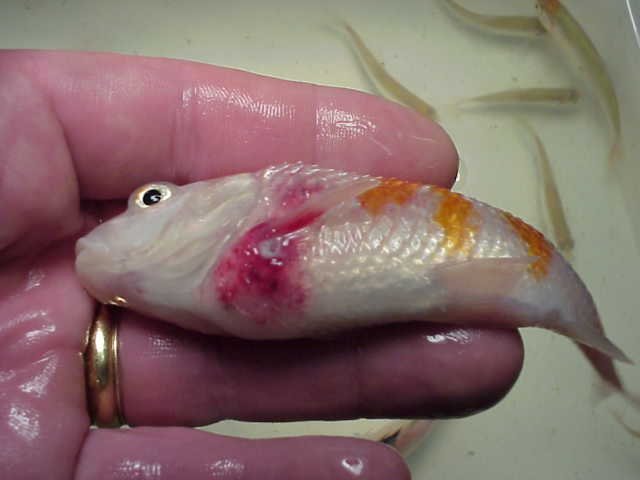Koi bacterial disease
A serous threat that requires prompt action
Bacterial disease, ulcers, fin-rot and stress
Two things are important to minimize the likelihood of serious bacterial infections such as ulcers affecting our koi. Firstly, early diagnosis and treatment is vital to limit the spread and severity of infection, both in individual fish and throughout the pond. Secondly, an understanding of the primary causes of bacterial disease will help prevent problems occurring and getting out of hand.
However, I should stress that we should not look at these problems in isolation and think that bacterial diseases just occur out of the blue. Invariably they are preceded by stress factors or stressors – for example, poor water quality or parasite infection – which create the conditions for these diseases to develop in the first place.
As with any animal, koi have evolved sophisticated defence systems against the bugs and germs that constantly surround them. A sample of even the cleanest, clearest pond water will contain millions of bacteria, many of which are the opportunistic type that can quickly take advantage of any weak or stressed fish, in the same way that we are surrounded by germs that have the potential to make us ill. But the bacteria that cause most common ailments are naturally present in the pond, and only become a problem when they overcome the fishes’ weakened defence systems.
Fish defences
Fish have two basic defence mechanisms to keep bugs and germs at bay. First, the mucus that coats a healthy fish contains various chemical substances that discourage parasites, fungi and bacteria. In addition, the mucous layer is being continually sloughed off and renewed, making it difficult for bugs to become established and proliferate. For bugs, it’s a bit like trying to climb a greasy lamp-post! It should be noted that some chemical treatments, such as benzalkonium chloride, can remove this protective coating and any irritants in the water – for example raised ammonia levels – can result in a thickening of the mucus coat, which creates ideal conditions for parasites and bacteria to multiply.
An active immune system
The other protection fish have in common with other animals is an active blood-based immune system. White blood cells circulating around the body detect ‘foreign’ invaders in the blood and tissues and by various methods attack and destroy them. There are two important qualifications to add to this over-simplification of the immune system. First, it is strongly temperature dependent, being far more effective at higher temperatures, and becoming virtually non-existent at temperatures below 10oC to 12oC. The second consideration is that it is affected by stress.
A stressed fish will have a greatly reduced immune response compared to a healthy, unstressed fish. Because stress has this disruptive effect on the immune system any form of prolonged stress is potentially dangerous and often a precursor to health problems. It is this constant need to consider all factors that makes diagnosis and treatment so difficult because, as we can see, it would make no sense to treat a stressed fish suffering from a parasite or bacterial infection until we had first rectified or removed the cause of the stress.
Problem sources
Ponds are ideal breeding grounds for bacteria, especially if the water is slightly polluted with fish waste, decomposing food and other organic matter. A build-up of decomposing organic matter provides ideal conditions for bacteria to multiply. Very few bacteria are pathogenic (disease-causing) and the majority of those which cause problems are opportunistic. So provided the background level of bacteria is kept at a reasonable level by routine pond and filter cleaning and maintenance, and the fish are fit and well, there should be few opportunities for bacteria to cause problems.
There are times of the year that are inherently stressful for koi -during early spring, for example, before their immune system has really woken up, and at spawning time which is very stressful for both males and females.
It is worth noting that young fish approaching puberty are likely to be susceptible to diseases due to hormonal changes.
Ulcers
 Fish are susceptible to a variety of infections. Some diseases show no outward signs and do their damage inside the body, attacking vital organs and systems. Luckily, this type of infection is rare, as the first outward signs are normally a number of seemingly healthy fish dying for no apparent reason. The most common infections encountered by owners are usually associated with ulceration and fin-rot.
Fish are susceptible to a variety of infections. Some diseases show no outward signs and do their damage inside the body, attacking vital organs and systems. Luckily, this type of infection is rare, as the first outward signs are normally a number of seemingly healthy fish dying for no apparent reason. The most common infections encountered by owners are usually associated with ulceration and fin-rot.
The first signs of a infection are usually the appearance of red spots or red areas on the body. These inflamed areas can appear anywhere on the body, often starting with inflammation near a scale.
Common sites are around the mouth and at the base of fins, especially fins on the lower part of the body, the ventral and anal fins. Unfortunately, these initial signs are often missed and the infection is not noticed until a larger open ulcer appears.
An ulcer is a break in the skin, often circular but not always, which is usually inflamed, looking very red and angry. Because the appearance of a infection is not always noticed until fairly advanced, koi-keepers tend to think the ‘sudden’ appearance of an open wound is due to the fish cutting itself on a pipe or rocks, They may leave the wound to get better but in the case of a bacterial infection it simply gets worse.
Fish do occasionally cut themselves but it is rare and the appearance of any open wound should be taken seriously, particularly if there are signs of inflammation. These open lesions usually become infected with other bacteria and fungi which obscure the underlying cause of the ulcer.
Fins are another main site for infections. The initial signs are at the edges of the fins. Often the caudal (tail) and pectoral (paddler) fins become opaque and frayed, sometimes becoming inflamed (red). In some instances the resulting ‘fin-rot’ appears as a discrete bite shape or a noticeable reddening. All fins are susceptible to infection, and this is usually stress related. Infections to the lower anal and ventral fins are relatively common so inspect the ‘undercarriage’ during your regular health checks. Again, it is rare for this type of damage to occur from fish biting each other or knocking against walls and pipes.
The above are all typical signs of bacterial infection. For a definitive diagnosis it may be necessary to have a bacteriological swab taken and sent to a laboratory for identification. This type of test will hopefully isolate the primary pathogen and determine the best antibiotic treatment to combat the infection. Without doubt, bacterial problems can be fatal but if caught at an early stage, simply improving environmental conditions may effect a cure.
It is important to realise that, with bacterial infections, affected fish can often create a reservoir of infection and spread the disease throughout the pond. Unless the problems are minor and resolved within a few days with the use of a proprietary treatment, it is likely that professional or other expert help will be needed. It is vital that bacterial problems are diagnosed and treated promptly as any delays in treatment simply makes matters worse.
Severely affected fish will usually need individual treatment and possibly isolation. If one or more fish are displaying signs of infection it is crucial that all fish are examined. Most outbreaks of bacterial disease tend to affect several fish, particularly when the cause is an underlying stressor such as poor water quality. In this situation it is important that all affected fish, no matter how minor their lesions, are noted and treated at the same time otherwise the infection will continue to spread throughout the pond, despite your efforts to control it.

